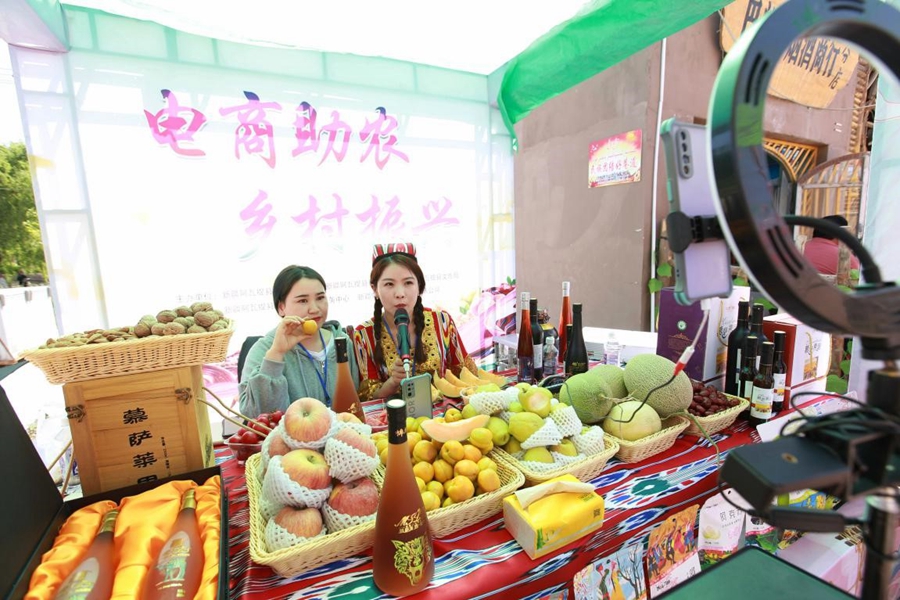E-commerce development in western China is moving onto fast track
Thanks to rapid e-commerce development, special local products from western regions in China have witnessed amazing sales during this year’s June 18 online shopping festival in China.
During the online shopping spree, a succulent plant grower in southwest China’s Yunnan province received more than 5,000 orders within three hours during a live-streaming promotion; a great number of trucks fully loaded with kiwifruit left Wugong county in northwest China’s Shaanxi province; and a hotpot business in a mountainous area of southwest China’s Chongqing municipality saw its daily sales volume exceed 100,000 yuan ($15,430).
Last year, the number of newly-added online shop owners from western regions of China on Taobao, a major online shopping platform run by Alibaba, surpassed that from the central and eastern regions of the country for the first time and led the whole country, according to a recent report jointly released by the digital economy research institute of Zhongnan University of Economics and Law and Alibaba Group.
Besides, the average transportation time of parcels between the eastern and western regions of China has been reduced by 16 hours in two years, suggests the report on e-commerce development in China’s western regions.
It also indicates that, Yunnan, Sichuan, and Shaanxi, three provinces in west China, made it into the top ten list of the country in terms of the number of live-streaming hosts who promote farm produce online.
In 2020, nine of the top ten provincial-level regions which witnessed the most year-on-year growth in the number of newly-added shop owners on Taobao were from west China, and the top five are all located in western China, including Ningxia Hui autonomous region, Yunnan province, Guizhou province, Qinghai province, and Gansu province, as shown by data from the report.
Owners of small and medium-sized Taobao stores from western China have seen a nearly 150-percent growth in the average amount of money spent through MYbank, a leading online private commercial bank under Ant Financial Services Group, compared with that in 2017, according to the report.
The gap between different regions’ natural endowments caused by geographic positions is an important reason for differences between their economic development, and digital economy is breaking the traditional regional gap, said Zuo Chenming, senior expert of Alibaba’s research arm AliResearch.
According to Zuo, the accelerated development of digital economy and application of digital technologies in western regions can be mainly attributed to the following reasons.
First, the infrastructure and logistics services in China’s western regions are increasingly improved. With the implementation of the strategy for large-scale development in the western regions, especially the construction of e-commerce infrastructure facilities, high-quality agricultural products in remote mountainous areas of the country’s western regions can now be transported to the cities.
Meanwhile, various platform companies have actively shifted their strategic focus to rural areas. For instance, Alibaba’s logistics arm Cainiao Network teamed up with major courier companies to extend its logistics network to counties, townships, and villages by leveraging digital and smart technologies. So far, it has established 30,000 rural delivery stations across China, and plans to open about 1,000 “fast lanes” for the transportation of agricultural products this year.
Second, the country is seeing more talents return to rural areas. While returning to their hometowns to start businesses, young people have brought new technologies, ideas and ways of thinking to rural areas, injecting fresh vitality and dynamism into villages. In particular, since the outbreak of the COVID-19 pandemic, the number of rural workers who return to their hometowns to start businesses has grown faster than before.
Third, as Chinese consumers favor increasingly high-quality, healthy and fresh food, many quality products from mountainous areas in west China have embraced broader sales channels. In the meantime, the increasing popularity of the new business form of live-streaming and active efforts of government departments have made e-commerce an important platform for increasing the income of farmers in western China.
Driving the development of core industries through e-commerce is becoming an effective key to bridging the development gap between western China and the country’s central and eastern regions, said Pan Helin, executive director of the digital economy research institute of Zhongnan University of Economics and Law.
At present, e-commerce has entered the stage featuring live-streaming, Pan said, adding that with the popularization of 5G applications, live-streaming videos with low latency and high definition have significantly improved the experience of both sellers and buyers and created brand new space for the development of e-commerce and even digital economy in west China.
“E-commerce can expand the sales area of products, improve people’s consumption level, drive fixed-asset investment, and bring foreign trade to a new level, which is particularly valuable to western regions’ rural vitalization and efforts to avoid the phenomenon of ‘hollow villages’, where there are only the elderly and children as young people leave their hometowns to work in cities,” Pan pointed out.
As more and more western regions in China actively promote the use of the Internet, digital economy and digital technologies in there will move onto a broader and faster track of development, Pan noted.
 |
Photos
Related Stories
- Digital economy thrives in China's western regions: report
- Xinjiang's Alashankou port sees roaring cross-border e-commerce business
- China to enhance freight-train service to boost cross-border e-commerce
- China's e-commerce logistics activities expand in April
- E-commerce platforms bring global brands closer to Chinese customers
- China establishes e-commerce cooperation mechanisms with 22 countries
- Malaysian entrepreneur's e-commerce dream from China turns into reality
- Primary-level cadres in China join livestream e-commerce for poverty alleviation
- China guides e-commerce sector to greener path of development
- Rwandan e-commerce student in China hopes to be an influencer back home
Copyright © 2021 People's Daily Online. All Rights Reserved.











